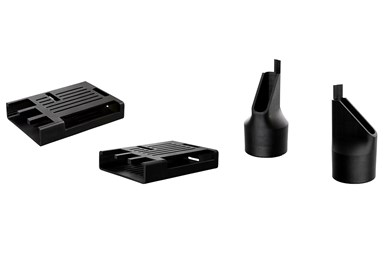Nexa3D Chooses Mechnano’s MechT for 3D Printing of Static-Dissipative Parts
Nexa3D’s xESD resin is said to provide an innovative and cost-effective solution for fabricating high-resolution, static-dissipative parts required in a multitude of electronics applications.
Nexa3D, a global provider of ultrafast polymer 3D printing solutions, has released an ESD-safe resin for the fabrication of static-dissipative parts, powered by Mechnano’s MechT. It is said the Nexa3D xESD resin provides an innovative and cost-effective solution for fabricating high-resolution, static-dissipative parts required in a multitude of electronics applications, as well as on the factory floor when handling critical electronics components.
The resin answers the demand for rapid production and prototyping, enabling users to create custom jigs, fixtures, grippers, assembly aides and enclosures in hours without the risk of ESD damage to high-value electronic components.
The xESD is a rigid photoplastic material, which uses Mechnano’s MechT technology to create a stable carbon nanotube dispersion that delivers optimal static-dissipative performance and isotropic mechanical properties, which are required by the electronics manufacturing industry.
MechT technology enables detangled and separated carbon nanotubes to be dispersed throughout an additive manufacturing (AM) material without reclumping. In addition to ESD, the company says the resulting discrete tubes can be tailored to specific performance requirements and deliver previously unattainable performance, such as a 50% increase in tensile strength, 200% increase in toughness or 850% increase in tear resistance.
“Nexa3D’s new xESD provides an extremely valuable additive manufacturing solution for electronics applications and manufacturing,” says Bryce Keeler, Mechnano president. “We’re excited MechT is now available on Nexa3D printers, and we look forward to working with them in the future on resins that answer the needs of additional industries.”
Mechnano says it is the first company to fabricate parts with carbon nanotubes using vat photopolymerization systems to achieve static-dissipative properties or improve impact, tear-resistance and tensile performance. The Nexa3D xESD material is available in black for both the newly released NXE Pro series printers as well as the XiP desktop 3D printer.
- Read about how Mechnano is bringing the promise of carbon nanotubes (CNTs) to life within various modalities of 3D printing and how these tiny additives deliver macro-level material improvements.
- Learn how NASA’s Orion spacecraft gets a lift from Stratasys’ electro-static dissipative (ESD) material.
Related Content
-
ActivArmor Casts and Splints Are Shifting to Point-of-Care 3D Printing
ActivArmor offers individualized, 3D printed casts and splints for various diagnoses. The company is in the process of shifting to point-of-care printing and aims to promote positive healing outcomes and improved hygienics with customized support devices.
-
What Does Additive Manufacturing Readiness Look Like?
The promise of distributed manufacturing is alluring, but to get there AM first needs to master scale production. GKN Additive’s Michigan facility illustrates what the journey might look like.
-
This Drone Bird with 3D Printed Parts Mimics a Peregrine Falcon: The Cool Parts Show #66
The Drone Bird Company has developed aircraft that mimic birds of prey to scare off problem birds. The drones feature 3D printed fuselages made by Parts on Demand from ALM materials.















